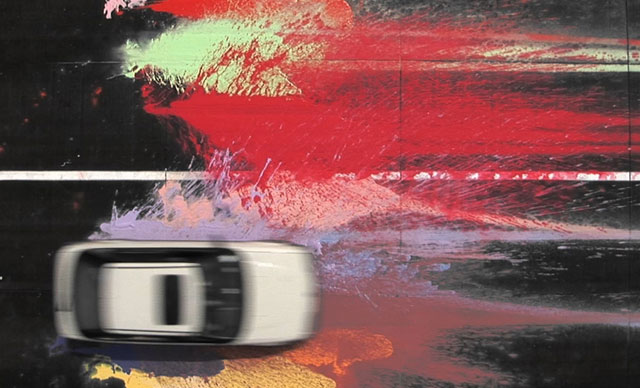
George Barber Automotive action painting
An incredible summer of art is under way at the University of Essex with postgraduate students from the Centre for Curatorial Studies in the School of Philosophy and Art History opening the first of two exhibitions.
Refractive Distance will be running at Art Exchange until Sunday 23 June and this show will be followed immediately by (Im)material Labour, a two-part exhibition supported by Arts Council England that will run at Art Exchange and Slack Space in Colchester simultaneously from Monday 24 June.
Curated, produced and organised entirely by Curating students as part of their course assessment, the annual MA exhibitions are a regular feature of Art Exchange’s programme.
Always offering exciting and interesting shows, this year is exceptional for many reasons. It is the first time two exhibitions have been devised simultaneously, one of the shows includes an off campus collaboration with Slack Space gallery in Colchester, Arts Council England has provided prestigious backing for one of the shows and two visiting students from the prestigious Ecole du Louvre Paris are working on the project.
Course director Dr Michaela Giebelhausen called the project an “invaluable opportunity” for the students.
She said: “We're trying to replicate the real work environment of gallery and museum work as closely as possible. Students are producing a real show in the University Gallery with real works and real budgets, and all the real problems that process entails.
"Students are encouraged to think critically about the display of works of art and also master every step from planning to realisation of their exhibition project. The devil is often in the detail. A good exhibition is one that wears all that behind the scenes work lightly, one that delights and informs.”
The first exhibition titled Refractive Distance brings together international artists who use art to destabilise common views of the world through canny use of illusion and scale. A mixed media exhibition it features film, photography, sound art and installation and runs until 22 June at Art Exchange.
Student curators Evi-Maria Pitsiava and Claire Kyle are excited to see people responding well to an exhibition which was born out of months planning, hard work, frustrations and success.
Claire said: “It’s great to have hands on experience; the exhibition takes on everything you’ve learned in theory and challenges you to put it into practice. Every piece of art we choose has different requirements for display - we’ve made contacts in galleries Europe-wide and worked hard to meet their requirements whilst also making an exciting viewing experience for people.”
Evi said: “Listening to people’s comments in the gallery and reading our guestbook is very rewarding. We have also built an interactive blog online at http://refractivedistance.blogspot.co.uk so audiences who otherwise couldn’t make it to Essex can enjoy the work.”
The second exhibition (Im)material Labour explores shifting social positions and changing patterns of working behaviour in contemporary society. Seeking to decode and humanise the financial crisis through analytical ideas and research, the artworks on display often result in therapeutic and humorous outcomes. Having received a prestigious grant from the Arts Council plus extra funding from the Essex Fund, Art Exchange and the Centre for Curatorial Studies, the exhibition will take place simultaneously at Art Exchange until 1 July and at Slack Space in Colchester until 20 July.
Curator Matylda Taszycka, a visiting student from the Ecole du Louvre spoke about the professional training that the process is providing, she said
“Organizing (Im)material Labour is an excellent professional exercise. We are responsible for the whole process of preparing the exhibition, which includes formulating the initial proposal; finding associates and exhibition spaces; raising funds for our project; looking for sponsorship; writing texts and press releases; organizing talks; and resolving technical problems.”
Asked what is the most exciting part of the project she replied: “Collaboration with living artists in order to produce new artworks for the show seems to be the most exciting part of the process. However, it also requires good mutual understanding, trust and control of the budget!”
The site specific work at Slack Space is designed with the experience of the audience very much at the fore. “Organising an exhibition makes us realize that an interesting idea and excellent artworks do not guarantee a successful show at the end. But the show is shaping up to be very successful, with a nationally significant grant from the Arts Council in hand, a lot of attention is being drawn to the exhibition.
“The positive response from such a prestigious institution as Arts Council England was very rewarding for our curatorial team. We are very proud we could receive their funding. Nevertheless, the openness and availability of the artists we invited to participate in our show is probably the most satisfying part of the process so far.”
More information about both exhibitions and their accompanying programmes of talks and tours can be found at the Art Exchange website www.artexchange.org.uk